Laser diagnostics of combustion processes
Thermal power and heat production is, and will remain as, an essential part of global power grid. To reduce its environmental impact, the combustion processes have to be optimized and novel environment friendly fuels must be introduced. These goals require new type of process monitoring and information that can be obtained using laser-based measurement techniques. High-temperature combustion processes offer interesting, challenging, and versatile environment for laser diagnostics with analysis objectives from fuel sampling and gas phase chemical kinetics to ash managing.
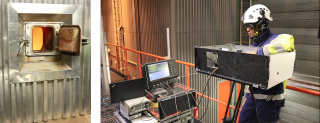
Currently, the laser diagnostic techniques used by Applied Optics group for thermal power and heat production related monitoring challenges include, for example, Laser Induced Breakdown Spectroscopy (LIBS), Raman spectroscopy, direct absorption spectroscopy, and in-house developed Collinear Photofragmentation and Atomic Absorption Spectrocopy (CPFAAS). The group collaborates actively with academic and industrial partners participating to measurement campaigns performed in laboratory-scale units up to full-scale power plants and developing novel advanced laser diagnostic techniques to tackle the monitoring needs that the plant operators face in changing field of power production.
Detection of pathogens in water
Laser-induced breakdown spectroscopy (LIBS) is an atomic emission spectroscopy technique, where laser pulses are used to create plasma on the sample surface. LIBS has many advantages over other atomic spectroscopy methods, including fast detection, no need for sample preparation, and ability to analyze a variety of sample types. Additionally, electrodynamic balance (EDB) levitation chamber is used to improve LIBS sensitivity by evaporating the sample and increasing control over its position.
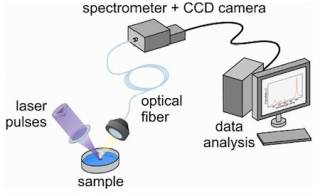
Presence of pathogens in water is a pressing problem in various industry fields, yet few methods of pathogen detection have been implemented so far. To tackle this problem, our group conducts research on the use of EDB trapping and LIBS as a fast and sensitive detection method of bacteria, parasites, and viruses in water droplets by means of electric field effects. Laser-induced fluorescence (LIF) and Raman spectroscopy are then used to achieve a more in-depth analysis of the samples. The project is done in collaboration with biological research groups in Tampere University.
Light detection and ranging (LIDAR)
LIDAR, standing for Light Detection and Ranging, is a convenient remote sensing technique taking advantage of light’s multiple properties to probe the matter. Lidar technology is widely used in various fields such as autonomous vehicles, archeology, astronomy, environmental conservation and atmospheric science providing remote 3D profiling of the environment.
Applied Optics group concentrates on developing novel atmospheric lidar techniques for weather and air quality research. The main projects target on simultaneous 3D profiling of aerosols, carbon dioxide (CO2) and wind speed with custom built coherent lidar instruments delivering fast and high-resolution measurements in a range of a few kilometers. The projects are carried out in collaboration with governmental and industrial partners such as Finnish Meteorological Institute (FMI) and Vaisala Oyj integrating the technology research to end user needs.
Supercontinuum applications
Supercontinuum is a broadband light, white light, source with laser like properties such as brightness and directionality. These features make supercontinuum an exceptional tool for optical spectroscopy. Applied Optics group, in collaboration with Ultrafast Optics group, develops new spectroscopic methods employing custom built supercontinuum sources.
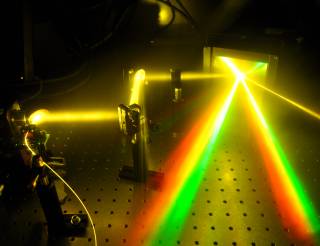

Recent projects include short-range LIDAR for combustion diagnostics, which aims at remote monitoring of flue gas parameters such as temperature and concentration in thermal devices like combustion power plants. This information paves the way for better process optimization. Another project in the field of gas sensing studies photoacoustic spectroscopy for more sensitive multi-gas detection, which has become increasingly important in environmental, medical and industrial applications, for example. Both techniques have great commercialization potential, thus the research is conducted in collaboration with industrial partners.
Optical detection of alpha radiation
The optical detection of radioactive alpha sources is possible by measuring the collision-induced fluorescence of nitrogen molecules in the air (see picture below). Alpha radiation excites atmospheric molecules via secondary effects. The process is similar to northern lights and the optical alpha detection is possible by measuring these “micro” northern lights around the radiation source.
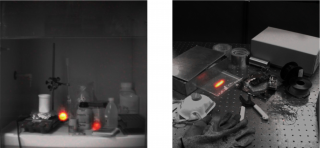
The benefit of the optical detection method is the long range of fluorescence photons which enables radioactivity measurements from a safe distance. On the contrary, conventional detectors require direct interaction with an alpha particle, and, therefore, the detection is possible only at distances shorter than alpha’s range. The optical method is feasible in environments where the level of ultraviolet lighting is low, preferably nonexistent. We focus on various alpha monitoring techniques which can be utilized in metal recycling and decommissioning as well as in nonproliferation inspection.
Direct laser writing of fluorescent metal nanoclusters
Direct laser writing is a well-known technique in which the refractive index of a transparent material is modified by light irradiation, enabling three-dimensional micro-structuring with sizes below the diffraction limit. Applying this method on metal-containing polymer and glass templates, we locally generate stabilized clusters of metal atoms within the templates. These clusters display intense fluorescence with great photostability over precise spatial distributions at the nanometer scale.
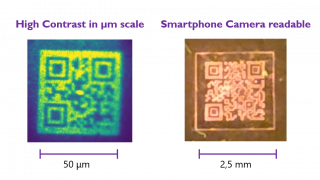
While polymers and metal salts are available as commercial products, our glass sources are made by Photonics Glasses group at Tampere University. Depending on the material and application, we employ different light sources, from near-infrared high repetition rate femtosecond laser to continuous-wave laser to light emitting diode. Our goal is to fabricate stable fluorescent nanostructures for applications in photonics, anti-counterfeiting and optical data storage. The technique is now heading towards commercialization by FluoroTrust.
